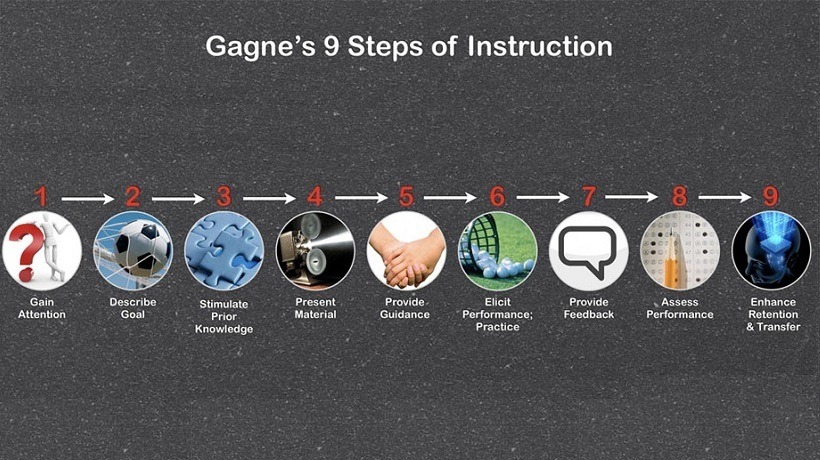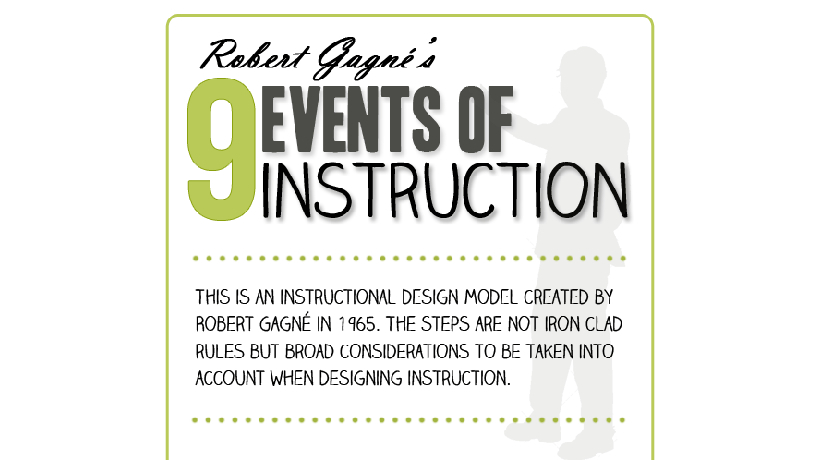Applying Gagné's 9 Events Of Instruction In eLearning
Gagné published The Conditions of Learning back in 1965, which suggested that certain mental conditions must be present in order for knowledge absorption and retention to occur. He also introduced the 9 Events of Instruction, based on the internal and external cognitive factors that contribute to learning. The internal factors are the learner’s prior knowledge, while the external factors are outside stimuli, such as the form of instruction. eLearning professionals can use these 9 events of instruction to develop eLearning experiences that stick and offer online learners the opportunity to engage in every step of the instructional process.
- Create an attention-grabbing introduction.
The first, and most important, event is gaining the attention of every learner in your audience. One of the most effective ways to do this is to create a compelling introduction that gets them hooked right from the start. Lead off with a story that pulls at their heart strings, or a question that surprises or shocks them. Even online learners who are distracted or possibly unmotivated to participate cannot resist an intro that creates an emotional connection and gets them thinking about the topic. - Inform learner about the objectives of the eLearning course.
This means that you must clearly state the goals of the eLearning course. Your learners must know WHY they need to actively participate in the eLearning course before they even access the first online module or activity. Be very clear about the objectives of the eLearning course, and tie it into real-world applications and benefits. If they know that they are going to take something valuable away from the eLearning experience, then they are more likely to engage in the online learning process. - Stimulate recall of prior knowledge.
Recalling and applying knowledge they have previously acquired gives online learners the chance to commit it to long-term memory, rather than forgetting it a second after they’ve read it. Before you start each eLearning activity, let your audience know what skills or knowledge they will be applying to the task, as well as how the subject matter is connected to information they already have in their knowledge base. - Create goal-centered eLearning content.
Each and every eLearning activity, online exercise, and piece of eLearning content should tie in directly to the goals and objectives. In fact, it’s best to group information and concepts together based on the specific goal. For example, an online lesson or module should focus on one core objective, which allows the learner to master that topic before moving onto the next. - Provide online guidance.
Even the most advanced online learners may need support when it comes to learning new skill sets and absorbing new knowledge. Otherwise, they may become discouraged or frustrated and disengage from the eLearning experience altogether. They must have the coaching they need to develop favorable online learning behaviors, or else they might be committing incorrect information to their long-term memory. - Practice makes perfect.
Repetition is key to absorbing and retaining new knowledge and skills. Thus, you should include plenty of opportunities for your learners to apply the knowledge they have acquired so far and try out behaviors that can help them in the real world. Offer them branching scenarios and simulations that give them the chance to see where their decisions lead them, as well as the rewards and risks involved that come of their actions. - Offer timely feedback.
By giving your learners timely and constructive feedback they have the power to improve learning behaviors and identify their weaknesses and strengths. Offer personal feedback, rather than giving general praise or criticism to your entire audience, so that every learner knows which steps they must take in order to reach their goals. - Assess early and often.
Assessing your learners not only gauges their progress, but also gives you the opportunity to identify weak spots in your eLearning strategy. For example, if a vast majority of your learners are struggling with one particular online module, you may want to reevaluate its online content and activities. eLearning assessments also offer you the ability to identify the knowledge gap, which is what they already know versus what they still need to acquire in order to achieve the learning objectives of the eLearning course. - Enhance transfer of knowledge by tying it into real world situations and applications.
Your learners must always be aware of how they can apply what they have learned once they step out of the virtual learning environment. As such, you should include real-world scenarios, stories, and other interactive eLearning activities that show them the applications of the information and skills they’ve worked so hard to develop.Design the Best Learning Experience for your Adult Learners with the Most Engaging Branching Scenarios!Discover, choose and compare the top eLearning Authoring Tools with Branching Scenarios Functionality!
No matter what the eLearning goals are or who your target audience is, you can use Gagné’s 9 Events of Instruction to create effective and engaging eLearning courses for your learners. The primary objective of any eLearning course is to give your learners the information and skills they need to improve some aspect of their lives, and this strategy can help you to develop a complete eLearning experience that does just that!
While Gagné’s 9 Events of Instruction are ideal for a comprehensive eLearning course, there are instances wherein you learners may need immediate knowledge on-the-job. Read the article How to Use The 5 "Moments of Need" Model In Corporate eLearning to discover 5 tips that can help you incorporate the “moment of need” model into your online training strategy, so that you can give your corporate learners the information they need when and where they need it the most.









